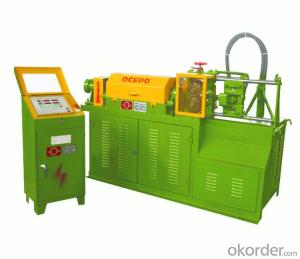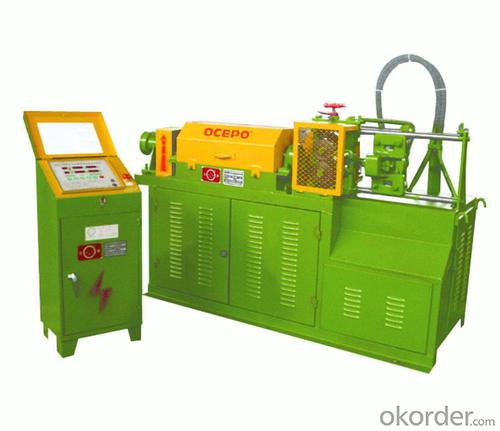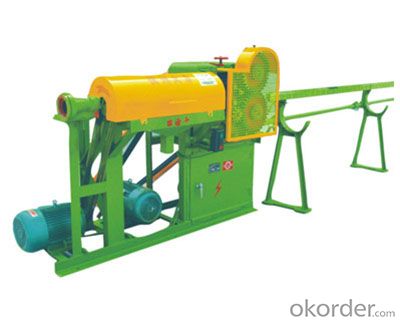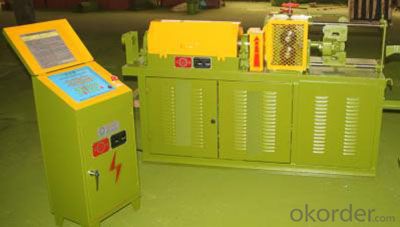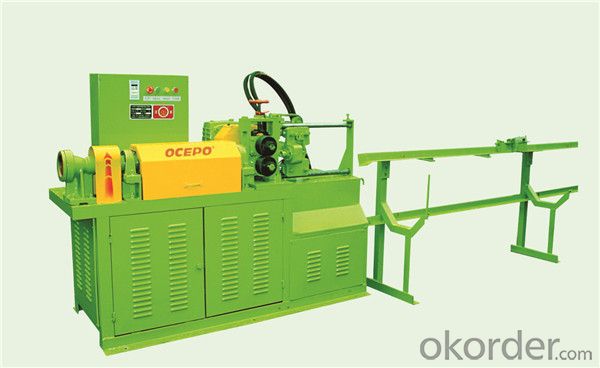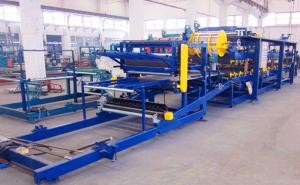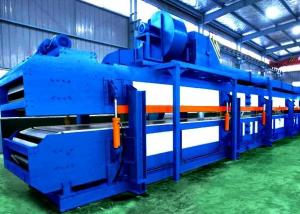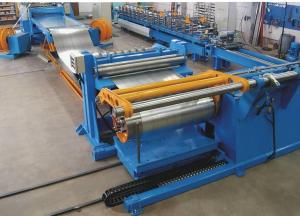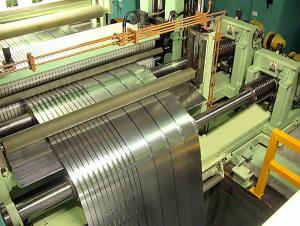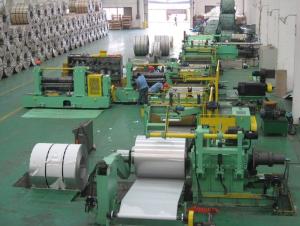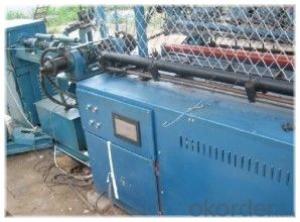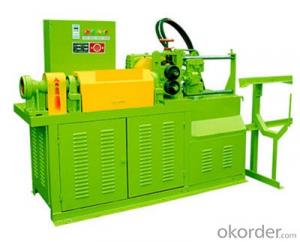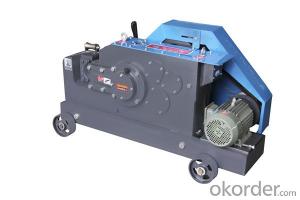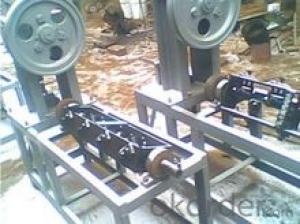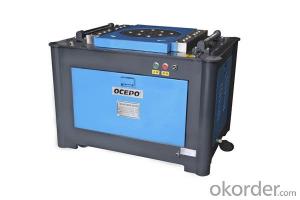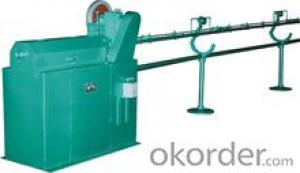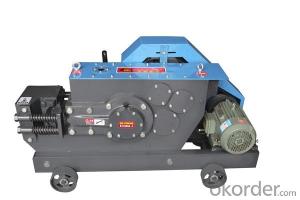CNC machine,Rebar Straightening and Cutting Machine
- Loading Port:
- Tianjin
- Payment Terms:
- TT OR LC
- Min Order Qty:
- 1 unit
- Supply Capability:
- 200 unit/month
OKorder Service Pledge
OKorder Financial Service
You Might Also Like
CNC machine,Rebar Straightening and Cutting Machine
Specification
Straightening Round Bar Dia.
Φ4-Φ12mm
Auto Cutting Length
500-8000mm
Straightening Speed
45m/min
Electromotor for Straightening
Model
Y132M-4
Rated power
7.5Kw
Electromotor for Cutting
Model
Y100L2-4
Rated Power
3.0Kw
Application
The machine is used to straighten and cut round bar (steel rod).
Advantage
1. Numerical control: automatic straightening and cutting, and save labors
2. Smart size and space saving
3. Easy to operate, with fast speed
4. Low material loss
5. Hydraulic cutting, have low noise
Payment
T/T L/C
Delivery
Within one week
Origin
China
Minimum Order
1 set
Packaging
Plywood case
Remarks
OEM & ODM, Buyer Label can be provided.
Packing
Plywood Case
Payment
T/T L/C
Delivery
Within one week
Origin
China
Minimum Order
1 set
Packaging
Plywood case
Remarks
OEM & ODM, Buyer Label can be provided.
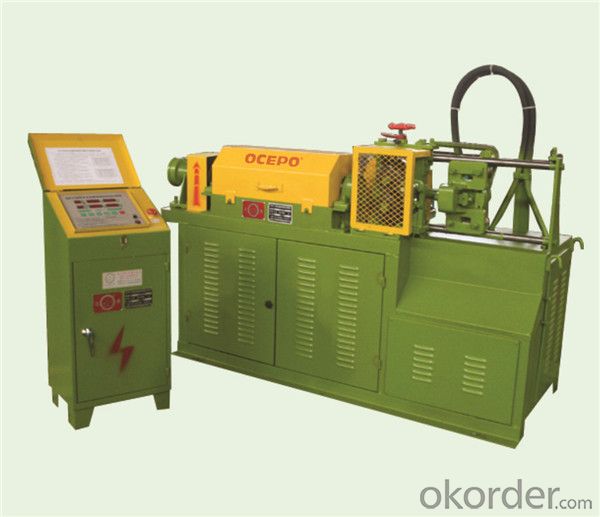
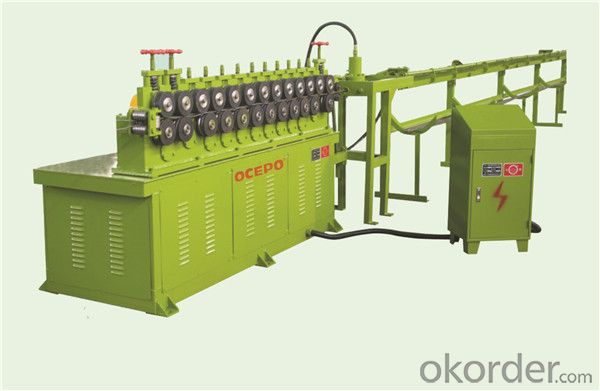
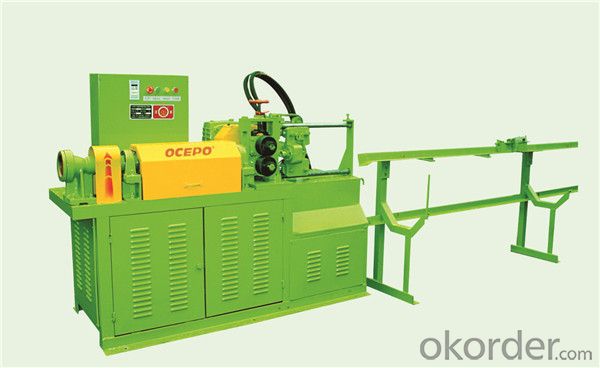

Company Direction
We are China professional manufacturer and system solutions provider of rebar connection machines,rebar processing machines and small road machines.
Founded in the 1990s. For 20 years, it has been focusing on the research, production and sales of rebar connection machines and rebar processing machines. The company is located in the capital of China - Beijing, has strong technical force, complete processing equipment and testing means. All the products are optimized by microcomputer design to reach the advanced level of industry.
- Q: How does metal straightening machinery contribute to improving the quality of metal components?
- Metal straightening machinery plays a crucial role in improving the quality of metal components in various industries. This machinery is specifically designed to correct any deformities or irregularities in metal parts, resulting in enhanced accuracy, precision, and overall quality of the final product. One of the key contributions of metal straightening machinery is its ability to remove any bends, warps, or twists in metal components. During the manufacturing process, metal parts can undergo various stresses and deformations, which can compromise their quality and functionality. Metal straightening machinery utilizes advanced techniques, such as hydraulic or mechanical presses, to apply controlled pressure and reshape the metal components, ensuring that they are straight and aligned as per the required specifications. By straightening metal components, this machinery also helps to eliminate any residual stresses that may be present in the material. During the manufacturing process, metals can acquire internal stresses due to factors like heat treatment, welding, or forming. These stresses can lead to dimensional instability, reduced strength, and increased susceptibility to failure. Metal straightening machinery counteracts these issues by redistributing the internal stresses and restoring the metal parts to their optimal condition, thereby improving their overall quality and performance. Furthermore, metal straightening machinery aids in improving the dimensional accuracy of metal components. Any deviations from the specified dimensions can result in improper fitment, decreased functionality, or even assembly failures. By utilizing precise controls and measurements, metal straightening machinery ensures that the metal parts are brought back to their intended dimensions, contributing to the overall quality and reliability of the final product. Moreover, metal straightening machinery also plays a vital role in enhancing the aesthetic appeal of metal components. Surface imperfections, such as dents, scratches, or waves, can greatly impact the visual appearance of metal parts. Metal straightening machinery effectively removes these imperfections, providing a smooth and flawless surface finish, which not only enhances the appearance but also improves the corrosion resistance and durability of the metal components. In conclusion, metal straightening machinery significantly contributes to improving the quality of metal components by rectifying deformities, eliminating residual stresses, improving dimensional accuracy, and enhancing surface finish. By ensuring that the metal parts meet the required specifications and standards, this machinery plays a crucial role in enhancing the overall functionality, reliability, and visual appeal of the final product.
- Q: Is the machinery suitable for straightening metal parts with a high degree of surface roughening or texturing?
- Several factors determine whether machinery is suitable for straightening metal parts with a high degree of surface roughening or texturing. The type and extent of the roughening or texturing on the metal parts are the first considerations. If the surface irregularities are minor and easy to correct, most machinery designed for metal straightening should be suitable. However, if the surface roughening or texturing is significant and presents challenges for the straightening process, specialized machinery may be necessary. For example, if the metal parts have deep scratches, dents, or other severe surface defects, machinery with advanced features such as adjustable clamping mechanisms, precision hydraulic systems, or specialized tooling might be required. The material composition of the metal parts is also an important factor to consider. Some machinery may be better suited for specific types of metals or alloys, while others may be more versatile and effective across different materials. Furthermore, the expertise and experience of the operator who handles the machinery play a crucial role in determining its suitability. A skilled operator can assess the surface roughening or texturing and make appropriate adjustments to the machinery settings to achieve the desired straightening results. To conclude, the suitability of machinery for straightening metal parts with a high degree of surface roughening or texturing depends on the severity of the defects, the material composition, and the expertise of the operator. It is advisable to consult experts or manufacturers to identify the most suitable machinery for specific requirements.
- Q: How easy is it to set up and install this machinery?
- Setting up and installing this machinery is a relatively straightforward process. The manufacturer provides detailed instructions and guidelines that simplify the installation procedure. The machinery is designed to be user-friendly, with intuitive interfaces and clear labeling of components. Additionally, the necessary tools and equipment for installation are typically included in the package. In most cases, no specialized technical expertise is required, allowing individuals with basic mechanical knowledge to set up the machinery successfully. However, for more complex systems, it is recommended to have a trained technician or engineer oversee the installation process to ensure optimal performance and prevent any potential issues. Overall, the ease of setting up and installing this machinery is commendable, making it accessible to a wide range of users.
- Q: How does metal straightening machinery handle different widths of metal?
- Metal straightening machinery is designed to handle different widths of metal through adjustable rollers or guides. These machines typically have a set of rollers that can be adjusted or replaced to accommodate various widths of metal. The rollers can be moved closer together or further apart to match the width of the metal being processed. Additionally, some metal straightening machinery may have adjustable guides that can be set to the desired width. These guides help to keep the metal in the correct position during the straightening process. By adjusting the guides, the machine can effectively handle different widths of metal without compromising the straightening quality. In some cases, the machinery may require manual adjustments to cater to different widths of metal. This may involve changing the roller spacing or adjusting the guides before starting the straightening process. Operators need to have a good understanding of the machinery and its capabilities to ensure proper handling of different widths of metal. Overall, metal straightening machinery is designed to be versatile and adaptable to various widths of metal. The adjustable rollers and guides enable the machine to effectively and efficiently straighten different sizes of metal, providing consistent and high-quality results.
- Q: Can metal straightening machinery be used for straightening metal containers and vessels with varying wall thicknesses?
- Metal straightening machinery has the capability to straighten metal containers and vessels of different wall thicknesses. The machinery is specifically engineered to exert controlled pressure and force, enabling it to bend or straighten metal objects. The straightening process can be customized to suit varying wall thicknesses by modifying the amount of pressure and force applied. By utilizing different configurations on the machinery, the straightening of metal containers and vessels with diverse wall thicknesses can be accomplished with utmost effectiveness and efficiency.
- Q: What are the maintenance intervals for metal straightening machinery?
- The maintenance intervals for metal straightening machinery can vary based on the specific machine and how it is used. However, there are some general guidelines that can be followed to ensure proper maintenance and the equipment's longevity. In general, it is advised to conduct routine maintenance on metal straightening machinery every 3 to 6 months. This involves checking the machine for any signs of wear or damage, such as worn-out rollers or components that are not aligned correctly. It is important to address any issues promptly to prevent further damage and ensure accurate straightening results. Along with regular inspections, it is necessary to regularly lubricate the moving parts of the machinery. This helps to reduce friction and wear, ensuring smooth operation and extending the equipment's lifespan. The frequency of lubrication will depend on the specific machine and how it is used, so it is advisable to consult the manufacturer's guidelines or maintenance manual for specific instructions. Furthermore, it is crucial to keep the metal straightening machinery clean and free from debris. Dust, chips, and other contaminants can accumulate over time and impact the equipment's performance. Regularly cleaning the machine and removing any built-up dirt or debris will help to maintain its efficiency and accuracy. Lastly, it is recommended to have a professional technician conduct a more thorough inspection and maintenance check on an annual basis. This will involve a detailed examination of the machine's components, alignment, and overall functionality. Any necessary repairs or adjustments can be made during this annual maintenance to ensure optimal performance and prevent any potential breakdowns. Overall, following a regular maintenance schedule for metal straightening machinery is crucial to keep it operating at its best. By conducting routine inspections, lubrication, cleaning, and annual maintenance checks, you can prolong the equipment's lifespan and minimize the risk of unexpected failures or expensive repairs.
- Q: What are the maintenance requirements for the hydraulic or pneumatic systems?
- The maintenance requirements for hydraulic or pneumatic systems include regular inspections, cleaning, lubrication, and replacement of components as needed. It is important to check for leaks, pressure loss, and any signs of wear or damage in hoses, fittings, valves, and seals. Regular cleaning of filters and strainers is necessary to ensure proper fluid or air flow and prevent contamination. Lubrication of moving parts such as cylinders, pumps, and motors is crucial to minimize friction and extend their lifespan. Additionally, monitoring the fluid or air quality and replacing it when necessary is essential for optimal system performance. Overall, regular maintenance and preventive measures are crucial to ensure the reliability, efficiency, and longevity of hydraulic or pneumatic systems.
- Q: How does metal straightening machinery handle the straightening of metal components with welding-induced distortions?
- Metal straightening machinery is designed to handle the straightening of metal components with welding-induced distortions in an efficient and effective manner. These machines are equipped with various features and capabilities that allow them to address the specific challenges posed by welding-induced distortions. One of the key features of metal straightening machinery is its ability to apply controlled pressure and force to the metal component. This allows the machinery to gradually and precisely manipulate the distorted metal back into its original shape. The level of pressure and force can be adjusted based on the severity of the distortions, ensuring that the metal is straightened without causing any further damage or deformations. In addition to pressure and force adjustment, metal straightening machinery also utilizes specialized tools and fixtures to support the component during the straightening process. These fixtures are designed to securely hold the metal in place, preventing any further movement or distortion while the straightening is being carried out. This ensures that the metal is straightened accurately and consistently, resulting in a high-quality end product. Furthermore, metal straightening machinery often incorporates advanced technologies such as laser measurement systems or optical sensors. These technologies allow the machine to accurately assess the extent and location of the distortions, providing real-time feedback to the operator. With this information, the operator can make precise adjustments to the straightening process, ensuring that the metal component is restored to its original shape with minimal error. Overall, metal straightening machinery handles the straightening of metal components with welding-induced distortions by applying controlled pressure and force, utilizing specialized fixtures, and incorporating advanced technologies. This combination of features and capabilities ensures that the straightening process is carried out accurately, efficiently, and with minimal risk of causing further damage to the metal.
- Q: What is the lifespan of metal straightening machinery?
- The lifespan of metal straightening machinery can vary depending on factors such as the quality of the equipment, maintenance practices, and frequency of use. However, with proper care and regular maintenance, metal straightening machinery can typically last for several decades.
- Q: How can the operator training programs for metal straightening machinery be customized?
- The operator training programs for metal straightening machinery can be customized by tailoring the content and duration of the training to meet the specific needs and requirements of the operators and the machinery involved. This can involve conducting a thorough assessment of the operators' existing knowledge and skill levels, identifying any gaps or areas of improvement, and designing training modules that address these specific areas. Additionally, the customization can include incorporating hands-on practical training sessions, providing comprehensive manuals and guides, and utilizing interactive training methods to enhance learning and retention.
Send your message to us
CNC machine,Rebar Straightening and Cutting Machine
- Loading Port:
- Tianjin
- Payment Terms:
- TT OR LC
- Min Order Qty:
- 1 unit
- Supply Capability:
- 200 unit/month
OKorder Service Pledge
OKorder Financial Service
Similar products
Hot Searches
Related keywords
